Opinion
Tom, schools us on how you can test your self-defense ammo in your everyday carry weapon.
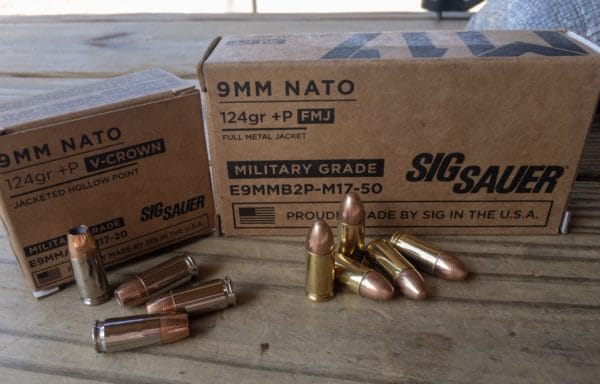
USA –-(Ammoland.com)- How do you go about choosing the right concealed carry ammo for your self defense handgun? There are eleventy-trillion loads on the market and twice as many opinions as to which is the best. There are endless articles and YouTube channels that do “self-defense ammo testing.” Some of them are legit while others are #FakeNews. It’s not necessarily about people being nefarious or incompetent; it’s more about the number of variables at play with ammo selection.
Some brands have excellent reputations, but it’s near impossible for any “brand” to guarantee that each of their caliber offerings, and each of the loads within each caliber offering, perform ideally in every variant of a handgun. Self-defense ammo performance is a careful balancing act between penetration and expansion (or sometimes fragmentation.) If velocity changes a hair higher or lower that delicate balance can be upset. So, it’s not that the fancy new Master-Blaster 9mm load is outstanding, but their .380 ACP load stinks. It’s more likely a factor of all those variables at play if you see performance differences between the two defensive ammunition rounds.
Here’s the bottom line. You should know what your specific self-defense ammo load will do in your specific gun.
As a responsible legally armed citizen, your best bet might be to narrow the universe of possibilities with research and test the top contenders yourself. Since we test a lot of ammo around here, I thought it might be helpful to walk through the process of hands-on ammo evaluation.
I just received samples of new ammo from Sig Sauer, the SIG Sauer 9mm +P, 124Gr, Elite V-Crown M17, JHP Ammunition. Let’s use it as the example case as we walk through the process. Since we’re talking about concealed carry, I will not test it in an M17 as that’s a little hefty for my preferred IWB carry method. Instead, I’ll use something more appropriate for concealment, the Sig Sauer P229 Legion 9mm.

Self-Defense Ammo Function
At the top of the checklist is a reliable function. If ammo jams in your gun, then it’s out of contention for carry use. Fortunately, to save on ammo testing cost, you can do some of this while checking other things like accuracy, point of impact, velocity, and penetration. If you do multi-task for function checking, be sure to load the mags all the way up and shoot the first and last rounds as part of your routine. If things will foul up with feeding, it’s likely to be at the beginning or end of a magazine. If you load your gun by chambering a round and then topping off the magazine with one more, test that way so you can duplicate actual carry conditions.
In this first outing, I shot about 110 rounds of the M17 ammo through the Sig P229 Legion, and everything worked like a champ. No failures to feed or eject and I made lots of holes in paper and blew up plenty of dirt clods on the berm. To be ultra-conservative, I’d want to shoot another 100 rounds or so before making it my official carry ammo for this pistol.
Self-Defense Ammo Accuracy
When I test for accuracy (or precision), I want to know how closely the bullets will impact relative to each other. In other words, how consistent is the ammo? I don’t care where the group falls, so I don’t waste any time “zeroing” the scope, optic, or iron sights at this stage.
Whatever the method, use a stable rest and focus on perfect trigger technique for each shot. I always fire groups of at least five shots from 25 yards. Measuring the best two or three can boost the ego, but that won’t tell you much about the inherent consistency of the ammunition and gun combination. If you’re using a less precise sighting method, like iron sights, where your eyes can be a limiting factor, consider firing six or seven shots and counting the best five. The goal is to understand what the excellent self-defense ammo will do in your firearm, not to test your eyesight. It’s OK to take steps to minimize the “human error” influence which is usually far more significant than the variance of the equipment and ammo.
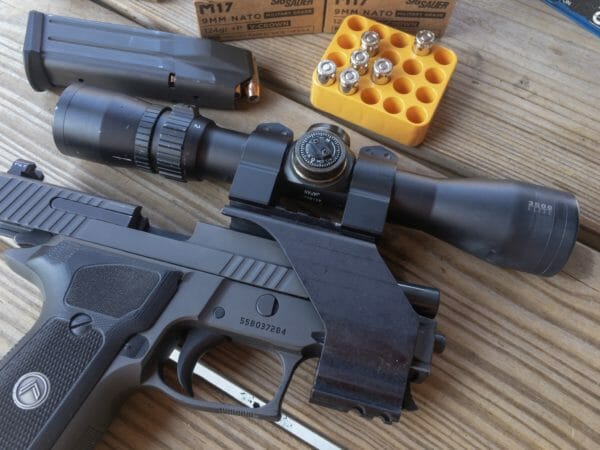
A while back I invested in a UM Tactical Rail Mount. This little gadget allows you to stick a red dot sight or handgun scope on any pistol with a forward rail. Using the, now discontinued, Bushnell Elite 3500 Handgun Scope shown here, I eliminate any “sighting error.” With magnification and fine crosshairs, I can aim each shot at my preferred 25-yard distance and know the results I’m seeing reflect what the gun and ammo can do.
So, with this nifty scope setup, how’d the Sig Sauer M17 9mm +P ammo perform? I shot multiple five-round groups, and they ranged between 1.28 and 1.84 inches. That’s excellent.
With all that said, how relevant is precise accuracy testing for self-defense ammunition and concealed carry use? Not as much as the gun forums and media would lead you to believe. The “worst” ammo and gun combinations I’ve tested generated 3.5-inch groups at 25 yards, give or take. That’s plenty precise for concealed carry use as you won’t be shooting to the full capability of the gun and ammo under those conditions. If you’re shooting one-inch groups at moving targets while actively engaged in a running fight for your life, then you’re not from this planet. Or you have a problem with reality.
Self-Defense Ammo Point of Impact
While accuracy (or technically speaking, precision) testing tells me how consistently self defense ammunition performs, point of impact validation tells me where it hits relative to the sight picture. Verifying point of impact is essential. Ultra-light bullet-for-caliber loads may have a radically different point of impact than a heavy-for-caliber projectile. That’s not bad, it just is different, and you need to account for it. Ideally, you would do that by making adjustments to your sights so you can aim where the bullet will strike.
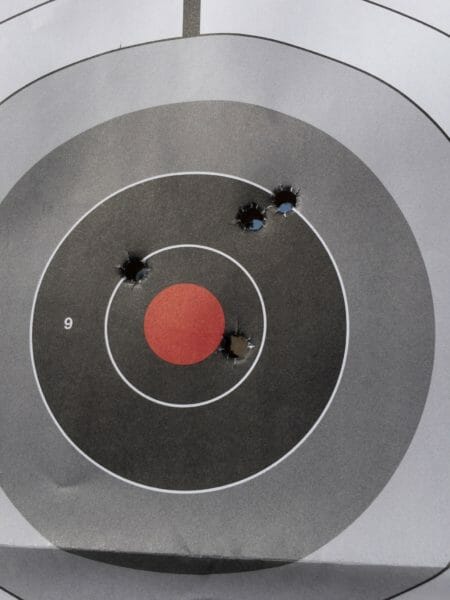
After shooting for accuracy/precision, I took that bulky scope off the P229 and shot with iron sights again at 25 yards. I used a sandbag rest to take any of my wobbles out of the equation. Good news for the Sig Sauer M17 +P! Shots impacted around the bulls-eye closer than I can hold standing, so we’re good to go – no sight change would be required if this were to be my carry ammo.
Self-Defense Ammo Velocity
Does velocity matter when choosing your concealed carry ammo? Not in most situations. The published velocity numbers on the box are usually measured with test barrels and are higher than what you’ll measure at the range with your carry pistol and your self-defense ammo.
For example, the M17 +P is rated at 1,198 feet per second. The P229 Legion shown here is a compact carry gun with just a 3.9-inch barrel so that velocity will be less than the published figures. That’s OK, I’m choosing a shorter barrel gun for concealment, so that’s expected.
I broke out my all-shot-up Shooting Chrony Beta Master Chronograph to clock the Sig Sauer M17 ammo from this pistol and found out that even though this old workhorse seems to work, my chrony has been perforated one too many times. The average velocity came out to 1,030 feet per second, and I know that’s wrong based on other 124-grain loads I’ve tested from the same gun back when my chrony was full of vigor but not holes. Time to upgrade to a Labradar Doppler unit…
So, normally I measure velocity, mainly because I’m an ammo geek. If you have a chronograph, great. If you don’t, and can borrow one from a friend, it might be interesting to see how your chosen ammo performs from your gun. I wouldn’t worry too much unless you find huge variance in the measured result as compared to what’s printed on the box.
Penetration and Expansion
The FBI uses meticulously calibrated ballistic gelatin so they can weigh the performance of one load against another – in that controlled medium. For concealed carry use, we’re more interested in knowing whether those hollow points will expand and penetrate adequately when fired from our gun.
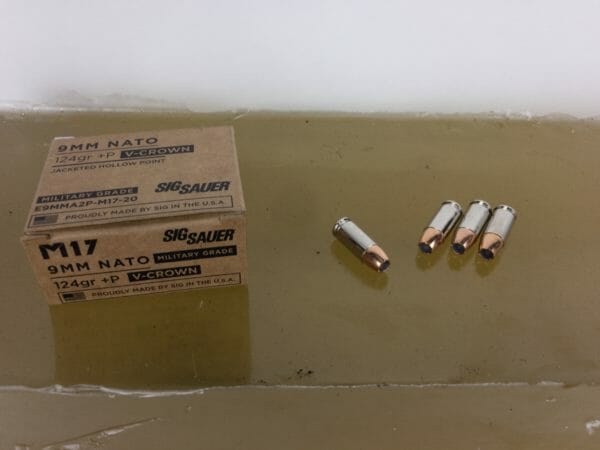
A quick word on bare gelatin tests before we go on. It’s satisfying to shoot bullets into pristine FBI gelatin or water, but that’s cheating. You’ll almost always witness beautiful expansion performance and end up with pretty flower-shaped projectiles you can photograph and post on Instagram. That’s not a great test, however. In the real world, bullets hit other barriers first, starting with clothing – sometimes heavy clothing. While still not a perfect representation of what happens when a projectile strikes organic material, covering that gel with heavy fabric layers will add challenge to your test. I use the FBI four-layer fabric barrier which consists of denim, insulation, and two cotton layers. The idea is to duplicate a shirt and jacket. Adding the heavy fabric layer separates the good ammo from the so-so stuff. Anything expands in bare gel. Fewer do so reliably after passing through the heavy fabric as it clogs up hollow points and inhibits proper expansion.
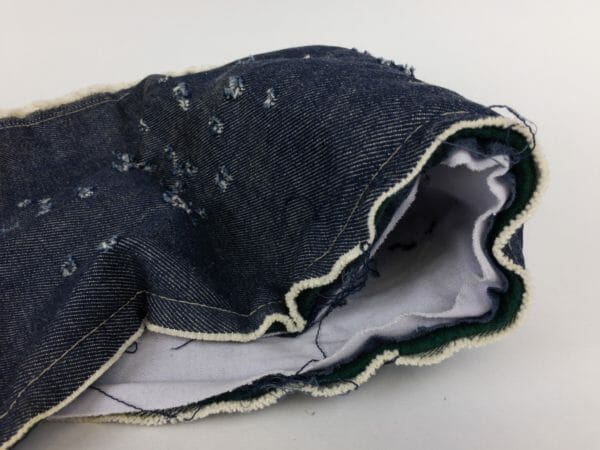
So, to test your own, you can invest in some ballistic gelatin, mix it up, and do the official way. Or you can use ready-to-go and reusable Clear Ballistics Gel. But gelatin is a pain, and it’s not cheap, so unless you want to do this a lot, it’s not worth the trouble. No worries! A substitute that won’t qualify for FBI measurements but that can help you understand your ammo performance is wet newspaper. Save the daily in a nice stack by piling it up flat in a plastic tub. When your pile is 20 inches tall or so, fill that tub with water and let it soak overnight. When you pour out the excess water, you’ll have a pile of soggy fake news. Turn the tub on its side and shoot. While the bullet retrieval process is messy, you’ll get an idea of what happens when you shoot into soft stuff.
So, what are we looking for? You’ll want to see those expensive hollow-point bullets expand to larger than their original diameter after passing through heavy fabric and into gelatin or wet newsprint. You’ll also want to see those bullets penetrate to a depth between 12 and 18 inches. That sounds like a lot, but when you factor in angles and the chance of hitting extremities first, that 15-inch average desired penetration depth is just right.
I shot the Sig Sauer M17 V-Crown +P into a 16-inch Clear Ballistics gelatin block covered with the official FBI heavy fabric layers. It’s a good thing I put a second block behind it because the bullets penetrated to 20+ inches. That’s good even though it’s more than the published 18 because Clear Ballistics happens to be a bit “slicker” than natural gelatin so penetration will always be more than in the stinky pig gel.
As you can see, the bullets expanded beautifully even after passing through the four layers of fabric. If you look closely, (click on the image above) you’ll see fabric debris caught up in them. I also weigh the bullets to see if they lost any mass from fragmentation. These didn’t and weighed in at 123.8 and 123.9 grains after I dug them out.
So there you have it, the complete process on testing Self-Defense Ammo. You don’t have to do all this. At a minimum, I would recommend lots of function testing, point of impact testing (that will give you some informal accuracy results), and expansion and penetration testing using wet newspaper if you have to. If you ever have to use your gun in self-defense, it’s wise to understand exactly what’s going to happen.
About
Tom McHale is the author of the Practical Guides book series that guides new and experienced shooters alike in a fun, approachable, and practical way. His books are available in print and eBook format on Amazon. You can also find him on Facebook, Twitter, Instagram, and Pinterest.

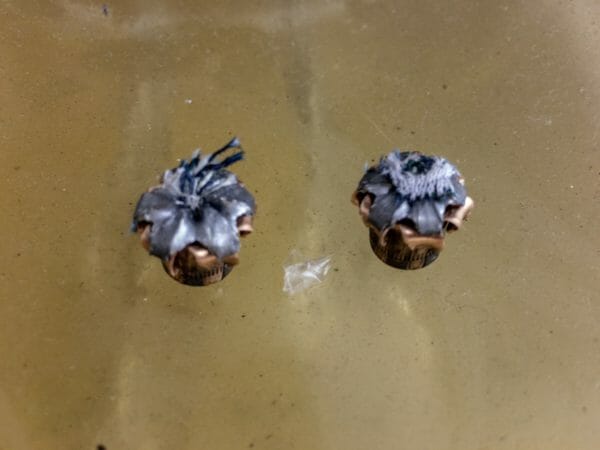
As it is impractical to mix up your own gelatin and test 200 rounds of a type of ammo you’re not yet committed to, I suggest going to Luckygunner.com/labs and use their comprehensive research on defensive ammo to narrow your choices BEFORE spending $1+ per round to test in your gun. That is unless you get ammo for free like the writer. LOL.
The folks at LuckyGunner do great work. However, there is one thing that someone else’s testing won’t show you. That’s whether your ammo functions properly in your gun – all the time. Always, always, always test your carry ammo in your gun before relying on it.
Dear Readers: I will turn 69 later this year if the Good Lord allows it. I started shooting at age 4 (1954). My dad was a “market hunter”, a bootlegger and a Rum Runner in New Orleans. I started “carrying” as soon as I legally could. I’ve seen a few things. Unless I read right over it, in which case I apologize, I believe the author may have missed one very critical item for anyone who wants that gun to go bang when they pull the trigger: BE SURE THE AMMO IN YOUR CARRY GUN IS CHEMICALLY SEALED AT THE… Read more »
You will love the Doppler, I do. It is so accurate that you can use your data with Hornady’s 4DOF at 100yd, then extrapolate at 1000 and it’s spot on. Plus it’s nice to know your exact velocities right down to the muzzle.
I am anxiously awaiting mine! i do a lot with airguns too and it will be really helpful for that as well. I’ve also found the optical ones have real issues with muzzle blast and some types of jacketed projectiles… Can’t arrive soon enough 🙂
Hey Tom, you may already know, but the pellet guns require a separate microphone. I tried to no avail to make it work without one. It’s interesting you mentioned pellet guns, because they are even more finicky about pellets than rifles are about bullets. I suspect it’s due to the pellet gun being a fixed charge affair. There was a fella at our last rifle club meeting touting the 22TCM. His claim was that it was doing 4100FPS. He said “it wouldn’t register on his chronograph,” to which I replied, “I have a doppler, it will register on that.” You… Read more »
Crud, one more thing…get a one of those 10,000ma/hr solar battery set ups and a SD card. The battery will definitely save you money and time, and extend your range time significantly. The SD allows the unit to record data other than the unit itself stores. You can take it home and download on your laptop for your write up.
Will definitely make someone’s year.